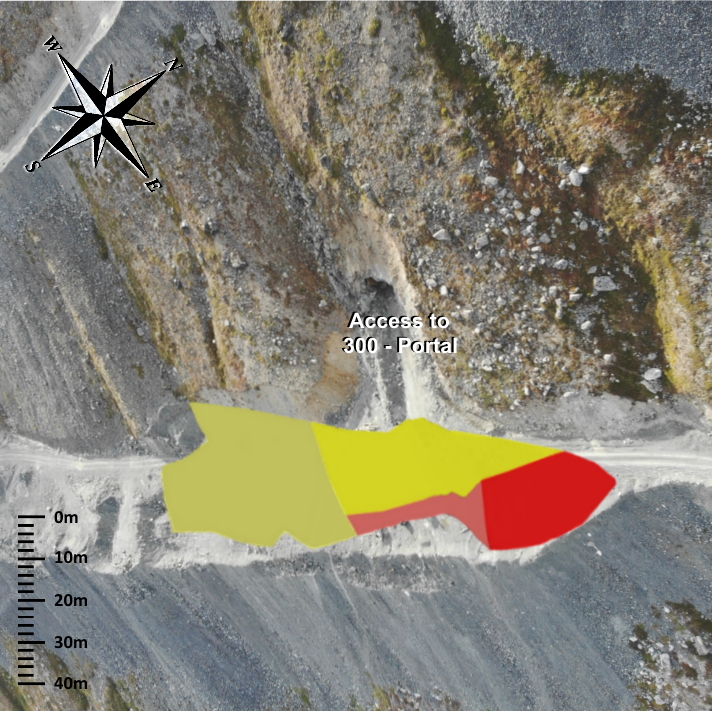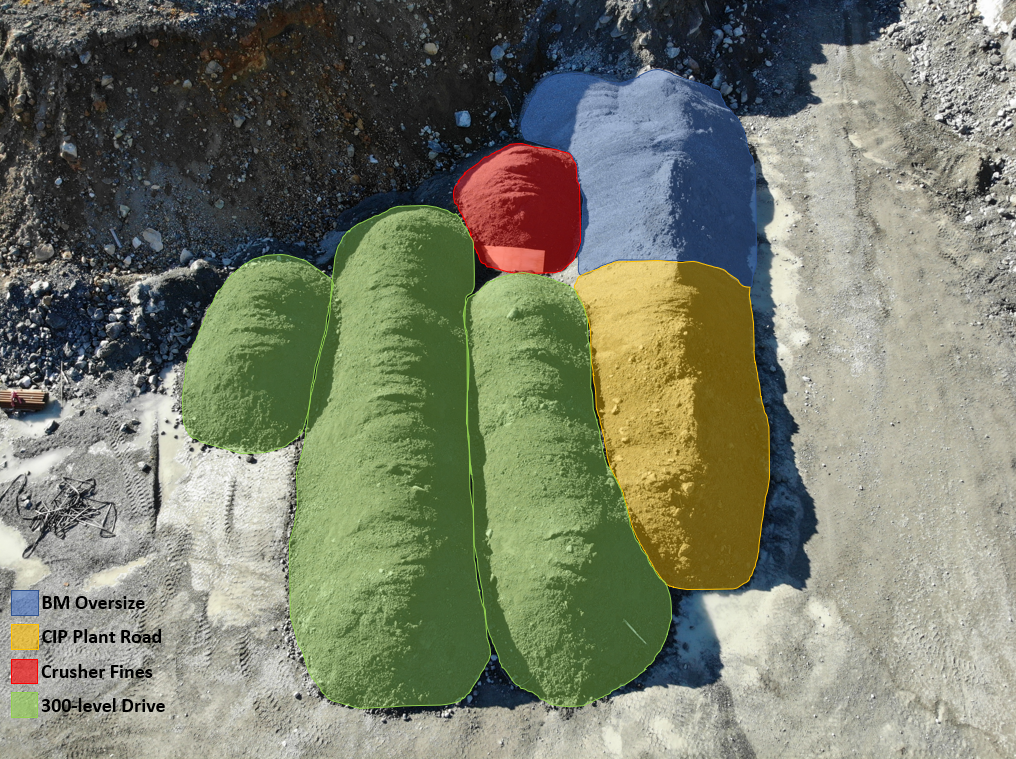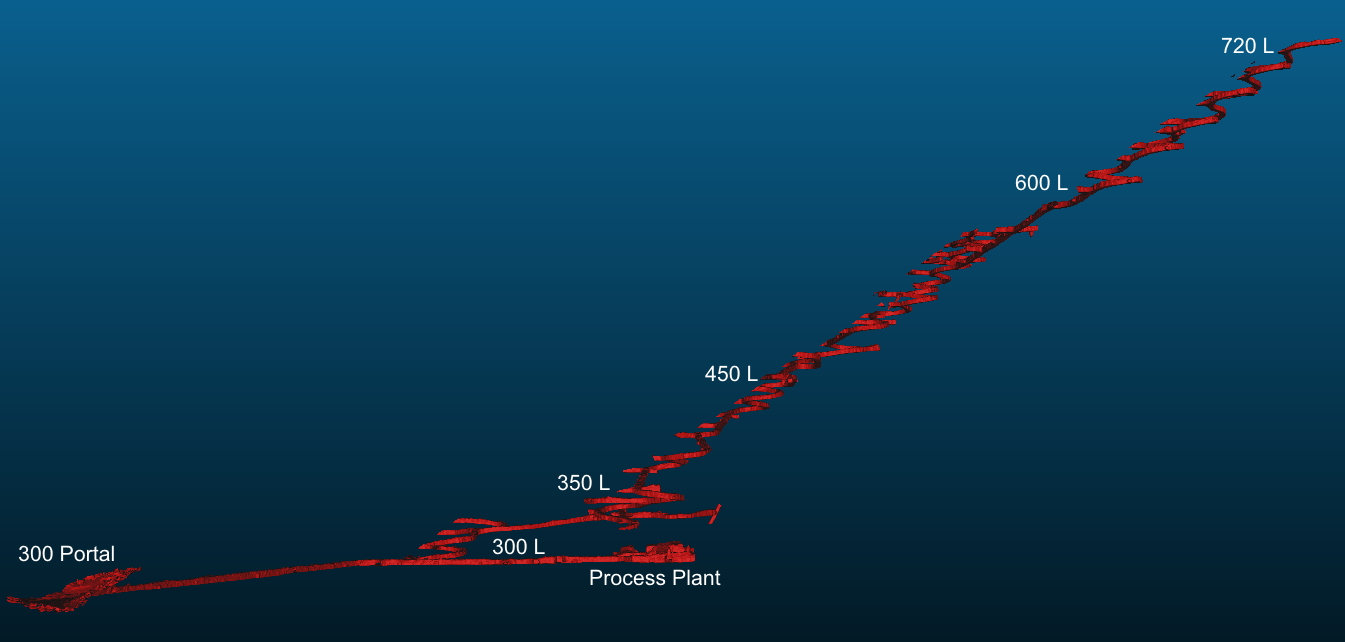TORONTO, ON / ACCESSWIRE / April 2, 2020 / AEX Gold Inc. (TSXV:AEX)("AEX" or the "Corporation") is pleased to provide an update on the results of the Corporation's 2019 summer activities aimed at producing an exploration target for the previously mined and processed materials left behind by past operators on its 100% owned Nalunaq license in South Greenland. The exploration target defined in this news release is in addition to the inferred resources of the Nalunaq deposit, and the underground sweepings and existing tailings outlined in the project's technical report entitled "An Independent Technical Report on the Nalunaq Gold Project, South Greenland" dated March 20, 2017 (effective date of December 16, 2016), prepared for Nalunaq A/S by SRK Exploration Services Ltd. (the "Nalunaq Technical Report"). The Nalunaq Technical Report is available on SEDAR (www.sedar.com) under AEX's issuer profile.
Key Highlights:
- The additional Exploration Target of remnant mining material at Nalunaq (see Table 1 below) has been estimated within the range of 17,000 - 25,000 tonnes at a grade of 3.0 - 7.0 g/t Au for 1,600 - 5,900 Oz (see the note below for further disclosure relating to this Exploration Target);
- This material is in addition to the historically mined and processed materials existing as mine sweepings (435-1,050 ounces Au) and the tailings (5,550 ounces Au) covered in the Nalunaq Technical Report;
- AEX intends to undertake further work to upgrade this exploration target into Mineral Resources.
The potential quantity and grade of this exploration target at Nalunaq and reported in this press release is conceptual in nature, and there has been insufficient exploration to define a mineral resource. The range of tonnages, grade and ounces should be considered as an "exploration target", defined under Section 2.3(2) of NI 43-101 Standards of Disclosure for Mineral Projects. It is uncertain if further exploration will result in this exploration target being delineated as a mineral resource. A discussion on the methodology used to calculate the range of tonnage, grade and ounces is provided at the end of this press release.
Table 1: Volumes, grades and tonnages of the various components of this exploration target separated by material type during the 2019 exploration program at Nalunaq.

The 2019 sampling program did not fully cover other zones which could contribute to this exploration target, such as additional fines in the underground process plant which were inaccessible with the available equipment on site during the 2019 exploration program, and did not include the ramp system in South Block, which is currently submerged up to level 270.
Detailed Summary of Findings
The intent of this section is to provide a general understanding of the source of the historical remnant mining material and to outline the methodologies used to estimate the range of tonnage, grade and ounces that form the Exploration Target. Sampling results are tabulated at the end of this press release in Table 2.
300 Level Pad
During the 2018 exploration program, the 300-level pad in front of the main access portal of the mine was sampled through eight test pits as during previous operations, run-of-mine material was crushed outside of the mine before being shipped offsite (during Crew Gold operations) or fed back to the underground process plant (during Angel Mining PLC operations). As such, AEX believed that the material of the 300-level pad was potentially gold-bearing. Results from the assays from the 2018 campaign indicated that the material constituting the 300-level pad was indeed gold-bearing, and in 2019 AEX sampled materials from six additional shallow test pits. See Figure 1 below illustrating the surface area of the 300-level pad:

Figure 1: Surface area of the 300-level pad sampled. Ball Mill oversize materials are illustrated in red shaded colours, and historically crushed material is illustrated in yellow shaded colours.
The results from the trenching program showed that the first 0.5 meters of material is mineralized with relatively high-grades (between 5 and 9 g/t Au), and the following 1 meter is also mineralized but at a lower grade (around 2 g/t Au). Beyond 1.5 meters in depth, the grades fall below 1 g/t Au, and have not currently been considered in the estimates of Table 1 above.
Sampling of the UG Process Plant Area
As illustrated in section 8.9.4 of the Nalunaq Technical Report, a variety of partially processed materials was left in various stockpiles around the process plant by past operators. Ball Mill oversize materials and fines around the two-stage crushing circuit and near the Carbon-In-Pulp ("CIP") area were identified as potentially gold-bearing. During the 2019 exploration program, AEX removed this material from the underground process plant to estimate its gold-bearing potential.
Fines from Crushing and CIP Areas
Figure 2: Left image: Fines in the crushing area before removal. Right Image: the same crushing area while the material removal activities were ongoing
The assay results on the fine materials from the crushing area yielded high grades, from 30 - 45 g/t Au, while the fines assayed around the CIP area yielded 10 - 15 g/t Au.
It is to note that while most of the fines from the crushing area were removed from the underground process plant, a portion of the fines near the existing fine material bins and around the CIP area could not be removed due to limited access. Notwithstanding, the remaining material can easily be removed once the accessibility issue is resolved. This material was not considered in the calculation of this exploration target in Table 1.
Ball Mill Oversize Materials
As observed around the crushing and CIP areas, ball mill oversize materials (pebbles from the milling process) were left stockpiled aside the existing ball mill by past operators. Given that this coarse material originated from the run-of-mine material, AEX suspected this material to be gold-bearing. The assay results from the ball mill oversize samples inside the process plant indicated grades between 7-10 g/t Au.
Figure 3: Left Image: Oversize materials in the ball mill area before removal. Right Image: The same ball mill area while the material removal activities were ongoing
300-level drive to Mill
The access to the underground process plant is through a 400 meters drive, with a cross section of 4.5m x 4.5m, from the main 300-level portal. See Figure 4 below:

Figure 4: 3D model illustrating the access drive from the portal at level 300 to the process plant, looking North
AEX suspected the material on the drive to the mill to be gold-bearing as the inspection of the drive's material indicated a mixture of coarse crushed material with fine material. During the 2019 exploration program, around half of the full 400m access drive (from the 300-level access drive to the process plant) was removed and stockpiled outside of portal 300. See Figure 5 below illustrating the excavation activities in 2019 on the main 300-level access drive:
Figure 5: Pictures of the excavation activities in the 300-level access drive to the existing process plant
The results on the assay of the samples sent out for analysis indicated that the material is gold-bearing, with grades between 1 - 4 g/t Au. Note that the second half of the 400 meters access drive, closer to the process plant, was not excavated nor sampled. This second portion of the access drive will be assessed in a subsequent program in 2020.
The stockpiles of the four material types (ball-mill oversize, crusher fines, and the material on the floor of the 300 drive and the plant) were stockpiled on the ROM pad at level 300 and are shown in Figure 6 below:

Figure 6: Gold bearing materials taken out of the underground mine during the 2019 exploration program
Sampling of the Ramp System - Target Block and Mountain Block
During past mine operations, poorly sorted silt to cobble size material has built up on the underground ramp at a thickness of 20cm to 40cm. See below Figure 7 illustrating the ramp system in Target and Mountain blocks:

Figure 7: Target and Mountain Blocks Ramp System, looking South
Material was sampled by trenching across the ramp with a mini-excavator at the entrances to each level from 300 Target Block to 720 Mountain Block and collecting composite samples. Samples were also collected at the midpoints between level entrances to better assess any variation in gold grade over this distance of approximately 4 km. Thicknesses were recorded in each location.
The average grade of the assay program on the ramp material returned approximately 4 g/t Au.
QAQC and Sampling Disclosure
Samples were placed in polymer bags with a sample ticket, weighed, and assigned a sample ID. Each sample was sealed with a security tag, which assigns a unique security ID to the sample.
Samples relating to the Ramp System and the 300 ROMPad were analysed by screen-metallics fire assay at ALS Loughrea, Ireland (see QAQC disclosure below). Sample preparation scheme PREP-31BY was used which involves crushing to 70% less than 2 mm, rotary split off 1 kg, and pulverizing the split to better than 85% passing 75 microns. Samples were then analysed by screen-metallics fire assay technique Au-SCR24 which has a detection limit of 0.05 ppm Au. CRMs and blank QAQC samples were inserted routinely within the batch. Each sample had, on average, a weight of 14.04 kg.
Samples relating to the stockpiles on the 300 ROM Pad were analysed by Impact Global Solutions at Delson, QC, Canada using 30g fire assay with AAS finish. A 1kg sample was crushed to 2mm, and a 250g sub-sample was pulverised to 95% passing 75 microns.
Calculation of tonnage, grade and ounce ranges
For the stockpiles on the 300 ROM Pad, volumes were estimated from measuring the dimensions of each stockpile and compared to a count of the number of loader buckets recorded for each material type. Sampling was undertaken using trenching systematically within the stockpile using a small excavator. Bulk density was estimated by measuring the weight of the material in a known volume. A range was calculated to express the uncertainty related to the estimate.
For the 300 ROM Pad itself, the thickness of the pad was recorded using 10 test pits in two main material types; ball-mill oversize and crushed material. Test Pits were dug using a small excavator, and samples were taken at every 0.5m depth. Each material type was mapped and digitised in 2D to produce a calculation of the area. Bulk density was estimated by measuring the weight of the material in a known volume. Assays were composited and weighted by thickness, and a range was calculated to express the uncertainty related to the estimate.
For the Ramp material, the thickness of the ramp material was measured at each sample point (between 0.2 m and 0.4 m thick), and the width of the ramp was also recorded. Samples were collected using a small excavator across the ramp at each sample point. Samples were taken at every level and between levels from the 300 level to the 720 level, totalling 55 samples. The length of the ramp was measured from the 3D solid of the underground survey. Bulk density was estimated by measuring the weight of the material in a known volume. Assays were weighted by thickness, and a range was calculated to express the uncertainty related to the estimate.
Table 2: Sampling results for the gold-bearing material
Qualified Person
The scientific and technical information presented in this press release relating to the exploration target of the gold-bearing materials has been approved by James Purchase, P.Geo. (OGQ 2082), Director of Geology and Resources of G Mining Services Inc. and independent to AEX Gold Inc. for purposes of National Instrument 43-101 - Standards of Disclosure for Mineral Projects ("NI 43-101"). Mr. Purchase is a member of the L'Ordre des Géologues du Québec, and a "qualified person" for purposes of NI 43-101. Mr. Purchase has visited the Nalunaq Project and has verified the exploration results reported in this press release.
Contact Information
George Fowlie, Director and CFO
1-416-587-9801
gf@aexgold.com
Eldur Olafsson, Director and CEO
+354 665 2003
eo@aexgold.com
Camarco (Financial PR)
Gordon Poole / Nick Hennis
+44 (0) 20 3757 4980
About AEX
AEX's principal business objectives are the identification, acquisition, exploration and development of gold properties in Greenland. The Corporation's principal asset is a 100% interest in the Nalunaq Project, an advanced exploration stage property with an exploitation license including the previously operating Nalunaq gold mine. AEX is incorporated under the Canada Business Corporations Act and wholly owns Nalunaq A/S, incorporated under the Greenland Public Companies Act.
Forward-Looking Information
This press release contains forward-looking information within the meaning of applicable securities legislation, which reflects the Corporation's current expectations regarding future events and the future growth of the Corporation's business. In this press release there is forward-looking information based on a number of assumptions and subject to a number of risks and uncertainties, many of which are beyond the Corporation's control, that could cause actual results and events to differ materially from those that are disclosed in or implied by such forward-looking information. Such risks and uncertainties include, but are not limited to the factors discussed under "Risk Factors" in the Final Prospectus available under the Corporation's profile on SEDAR at www.sedar.com. Any forward-looking information included in this press release is based only on information currently available to the Corporation and speaks only as of the date on which it is made. Except as required by applicable securities laws, the Corporation assumes no obligation to update or revise any forward-looking information to reflect new circumstances or events. No securities regulatory authority has either approved or disapproved of the contents of this press release. Neither TSX Venture Exchange nor its Regulation Services Provider (as that term is defined in policies of the TSX Venture Exchange) accepts responsibility for the adequacy or accuracy of this release.
SOURCE: AEX Gold Inc.
View source version on accesswire.com:
https://www.accesswire.com/583372/Additional-Exploration-Target-Defined-for-Remnant-Mining-Material-at-Nalunaq
